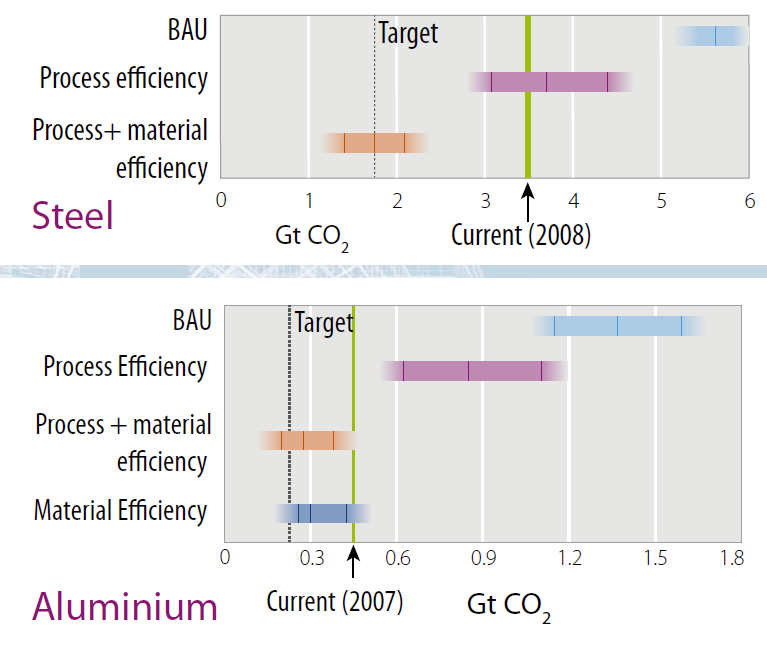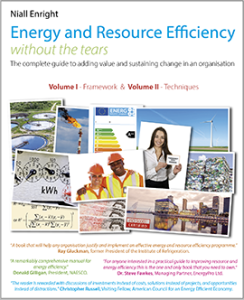[amazon_image id=”190686005X” link=”true” target=”_blank” size=”medium” container=”div” container_style=”float:left; padding-right:10px;”]Sustainable Materials with both eyes open [Paperback][/amazon_image]I was really excited to read this book since it comes from the same stable as the outstanding “Sustainable Energy Without the Hot Air“, by David MacKay.
I am delighted to report that this book did not dissapoint! In “Sustainable Materials With Both Eyes Open” the reader is treated to an equally accessible, fact-rich and thoroughly credible exploration of whether we can deliver our future material requirements in a carbon-constrained world with 50% fewer emissions.
The sustainability of materials is a huge and complex subject. Allwood and Cullen have made this task manageable by considering the five most significant materials in our modern economies: steel, cement, paper, plastic and aluminium, which together account for 5.35 Gt of annual CO2 emissions. This is a staggering 55% of industrial emissions or 12% of the global total of 44 Gt CO2, including those from agriculture and deforestation. In fact our top two materials, steel and cement, account for the majority of this total, 4.34 Gt of CO2, or 10% of global emissions.
The challenge the book sets itself is to determine if, taking into account very substantial projected growth in demand for these materials, absolute emissions reductions from the use of these materials can be cut by 50% by 2050. This is done by looking in depth at the life-cycle of steel and aluminium, how they are made, where they are used, the proportions which are recycled and so forth. The first part of the book sets the scene, where we get to understand the global numbers and flows of steel an aluminium. Then, in Part 2, we consider the supply-side of the equation (manufacturing the materials) “with one eye open”. In part 3 we move on to learning of the importance of the demand-side which enables us to consider the problem “with both eyes open”. Here we explore if we can reduce the need to these materials or increase the effectiveness whereby they deliver “services” such as strength, lightness, enclosure and so forth. In part 4 there is a briefer examination of the remaining three materials before proceeding onto the conclusions in Part 5.
One of the most striking aspects of this book is just how information dense it is. It seems to me that there is a huge amount of work that has gone into supporting the narrative – much of it which seems quite original. This quality stems undoubtedly from the sound industrial and academic credentials of the team who do not only have the pedigree of Cambridge University behind them, but also a £1.5m grant from the EPSRC to investigate carbon reductions in metal industries, called WelMet 2050. Although Julian Allwood and Jonathan Cullen are cited as the lead authors, they credit 6 other team members from their Department in Cambridge as contributors in the books’ official citation. No wonder then that we are presented with such an in-depth, fact-based, carefully considered analysis. I particularly like some of the novel graphics which attest to the care and effort put into communication key information clearly and powerfully.
I do urge you explore this book for yourself even if you only read the concluding section. I am confident that you will come away with new insights and energy to tackle the necessary changes in the way materials are used and produced.
It is essential at this point to dispel any impression that this attention to detail results in an indigestible meal. Quite the opposite. Great effort has been made to make this book highly readable, with glorious colour graphics and photos bringing the narrative to life throughout, and a style of writing that says “popular science” rather than “paper in Nature”. The device of imaginary conversations between Henry Ford and the Wright Brothers is used to highlight a key tension between standardisation (cheapness) and customisation (lightness and efficiency). Lego Bricks are used to represent stages of manufacturing and we learn that in the 1850’s aluminium was much more expensive than gold. To my personal taste this popularisation very occasionally detracts from what are essentially very profound messages in the book – for example the little musical extracts that are scattered don’t seem to contribute a great deal. However to dwell on this is to do a disservice because the book truly is a tour de force, making an intensely complex story with lots of technical content highly accessible. And there is a music CD to accompany the book available on Amazon – so you have to salute the authors for going the whole way with their ideas!
At the end of the day it is the key messages that matter. Once again this book brings home the sheer scale of change we need to undertake in order to achieve significant emissions reductions. These changes have to start on the demand-side material efficiency if we are to have any hope at all, and we will require some very powerful policy interventions to overcome the inherent barriers to change. Of all the opportunities to reduce emissions, life extension, more intense use and using less metal by design are shown to be the most effective strategies.
But demand-side changes will also need to be accompanied by supply-side process efficiency improvements in the way these materials are extracted and produced. Interestingly, Carbon Capture and Storage, often cited as a “silver bullet” for energy-intense industries, is rejected because of the uncertainty about its effectiveness. As in the case of energy generation we discover that the solution is to do all of the above, at an unprecedented scale and with unparalleled urgency. Welcome to the real world of climate change mitigation.
To achieve 50% CO2 emissions reduction arising from steel and aluminium use, at the same time as demand is forecast to double to 2050, requires every possible source of efficiency to be realised. Demand-side materials efficiency, such as life-extension, efficient design and more intense use are particularly important.
It is the unremitting focus on solutions that makes this an essential title for any resource efficiency or environmental practitioner. I don’t know about you, but I am sick to death with books that just tell me we have a problem! “Sustainable Materials with both eyes open” eschews repeating our crisis and gets its head solidly down to working out if we can solve our predicament. As a consequence it is a real breath of fresh air. Although there is a lack of data in some areas, the authors make clear the basis for the estimation that underpins some of their conclusions, and data sources are generally very well referenced. The resulting clinical examination of every source of improvement for the steel and aluminium industries has a high degree of credibility which lends great authority to the overall conclusions.
I earnestly hope that the solutions set out in this excellent book are taken seriously and the appropriate policies and incentives are put in place to make them come about. There is an excellent explanation, too, of the changes and choices that we have to make as individuals: whether as employees of the metals industries, as product designers, as buyers or as consumers.
This is a must-have title for anyone who is working on sustainability, climate change, life-cycle-assessment or who is just plain interested to know if we can sort our emissions mess out! My own copy is filled with annotations which speaks of the great insight and originality of this work, which has made clear a subject that was relatively unfamiliar to me. The authors and publishers, UIT, are to be congratulated for making the book available free of charge at www.withbotheyesopen.com, although the paperback edition is very modestly priced for such a well produced, full-colour title.
[easyreview title=”IMHO: Sustainable Materials with both eyes open” cat1title=”Usefulness” cat1detail=”A superb, solution-oriented, investigation of material sustainability. The concept of demand reduction followed by supply efficiency is applicable to almost all resource efficiency programs.” cat1rating=”4.5″ cat2title=”Relevance” cat2detail=”In depth coverage of Steel and Aluminium industries. Would have loved to see more on Cement, Paper and Plastics as these are different processes and provide somewhat different ‘Services’.” cat2rating=”3.5″ cat3title=”Accessibility” cat3detail=”Hugely readable with a very deliberate focus on accessibility. Fantastic graphics make this a remarkably approachable book considering its core topic.” cat3rating=”5″ cat4title=”Value for money” cat4detail=”Can’t get better than free! Even paid-for versions are very cheap.” cat4rating=”5″ summary=”A milestone in communicating solutions for material sustainability. Must read.”]
| [amazon_enhanced asin=”190686005X” /] | [amazon_enhanced asin=”B0067PR082″/] | KEY Usefulness: how will this book support a resource efficiency practitioner? Does the book give real-world examples and tools? Are reference to other sources of information well documented. Is it an objective and credible source? Relevance: how widely applicable is this book in delivering practical resource efficiency? Is it only for a narrow niche or are the concepts widely applicable? Are there good, contemporary examples of best practice? Accessibility: how well written and structured is the book? Is there an assumption about prior knowledge? Value for money: Taking into account the other parameters is this book a good investment? Overall: The average of the previous ratings. IMHO= in my humble opinion. Please post a response to the review if you feel I have got this wrong! |




0 Comments